Conventional electrodes on EMG/EEG/ECG systems require low contact impedance and therefore often skin preparation is needed. Disposable electrodes can become expensive over time and to improve conductivity, with many electrodes gel has to be used, which is annoying. Capacitive electrodes have the advantage of being reusable and due to their etremely low contact impedance they can make biopotential measurements unobtrusive by incorporating them into seats or measuring through clothing.
After coming across commercial capacitive electrodes I was curious how they perform and made a carrier board for the QFN electrodes. The devices require bipolar power supplies from +- 2.4 to 5V so they are compatible with the OpenBCI V3 boards which have +-2.5V. The PS25255 is the type I finally purchased because it is low power and low gain.
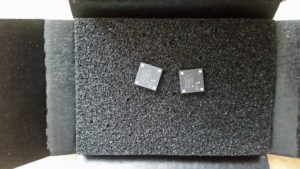
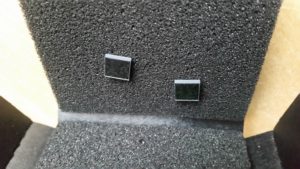
The things look very interesting. The actual contact surface has a mirror finish and looks like silicon. Strangely there is a gap between the electrode contact area and the rest of the package. I think this might cause problems because the electrode is designed to be in direct contact with skin and dirt might accumulate inside this gap.
The 4 contacts (VCC, VSS, GND and SIGNAL) are on the bottom side of the QFN package and therefore my approach of mounting them to the PCB is by having plated holes in the pads and soldering from the bottom side. Use sufficient amounts of flux and the solder reflows down to the contacts and you have a perfect connection.
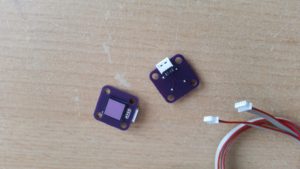
As a connector a 4-pin JST-style connector with 1.25mm pin pitch was used. I mounted it in a right angle to make the sensor flat. Crimping the female connectors using a PA-09 crimping tool was a challenge because they are so tiny.
Finally, I assembled an adapter board to break out the + and – 2.5V of the OpenBCI ‘Cyton’ board (AGND is already broken out on the right angle header) and tried to acquire some ECG. The signal outputs of both electrodes were connected to channel 1 an its gain was lowered to 2x (the PS25255 electrode itself already has a gain of 10). Also the channel has to be disconnected from SRB1 in the channel settings to make it ‘bipolar’.
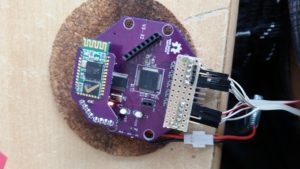
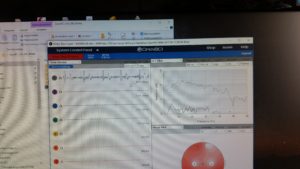
If placing the electrodes directly on the skin you get quite good results without any skin preparation. I was also easily able to acquire EEG by placing one eclectrode on the forehead and the other one on the neck. Hair distorts the signal too much.
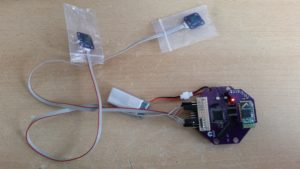
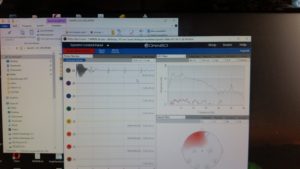
After putting both electrodes into plastic bags I was still able to acquire an ECG signal, but the signal was very sensitive to movement. Attempts to measure through a t-shirt were only successful if strong pressure was applied.
In all my experiments I did not use a drien right leg circuit or the bias output of the OpenBCI. Instead, only the software notch filter was enabled.
As a conclusion, I’d say that this was an interesting experiment, but 20$ per electrode seems a bit much for my hobby grade experiments. The Plessey EPIC electrodes seem to be usable for ECG, but their inability to penetrate hair for multichannel EEG is a little disappointing. It’s hard to tell how long the will last due to their peculiar packeage design. I will try some active electrode designs from the OpenEEG project with the OpenBCI soon, since they are easy to make, cheap and you can attach a comb electrode to it to be able to acquire EEG through hair hopefully more reliably than with passive electrodes.

Hello
I am a biomedical engineering student.
I’m doing a project at the university.
I have some questions about the ecg ps 25255 sensor
1. Can I get an electrocardiograph with this sensor?
2. What electrical parts are needed to set up this sensor?
3.How to set up this sensor ?
4.please send for me circuit diagrams for using this sensor.
5.Is the accuracy of this sensor sufficient?
6. Is ps25253 better than ps25255?
Thankyou
This is also my problem.
Hello,
I am an Electrical Engineering student at the Technical University of Munich. I’m writing my Bachelor’s Thesis and I need to measure EMG signals using the PS25201A / B and PS25203B sensors.
1. Can I measure EMG signals with these sensors?
2. What board is the best to use (I would like to link it with a raspberry to upload the results on a server).
3. What other electrical parts are needed and how can I set them up?
4. Are they accurate enough to measure an EMG signal?
Thank you for you time!